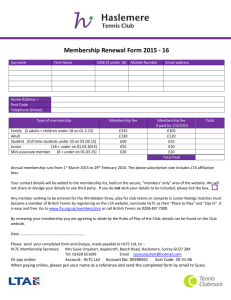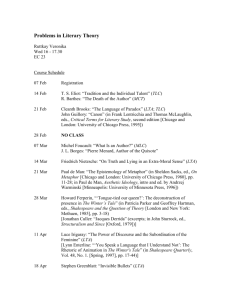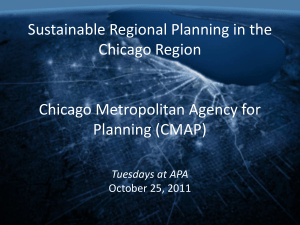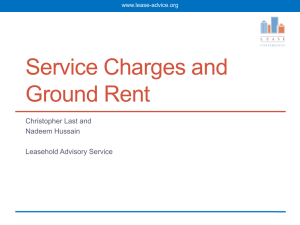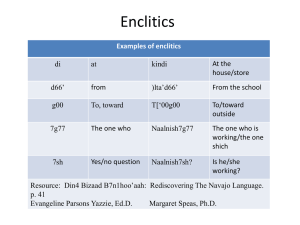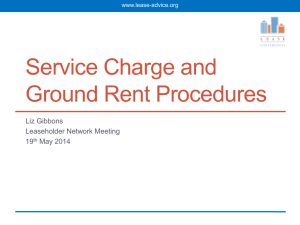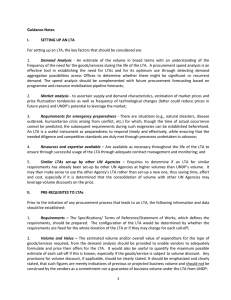- Repository@Napier
advertisement
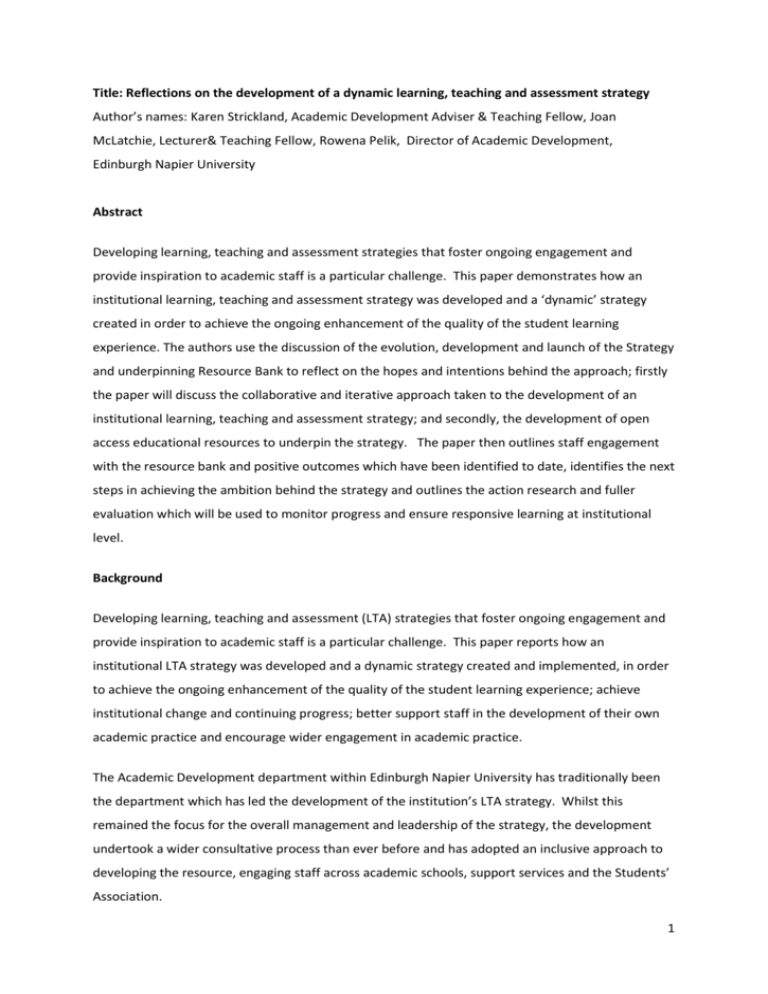
Title: Reflections on the development of a dynamic learning, teaching and assessment strategy Author’s names: Karen Strickland, Academic Development Adviser & Teaching Fellow, Joan McLatchie, Lecturer& Teaching Fellow, Rowena Pelik, Director of Academic Development, Edinburgh Napier University Abstract Developing learning, teaching and assessment strategies that foster ongoing engagement and provide inspiration to academic staff is a particular challenge. This paper demonstrates how an institutional learning, teaching and assessment strategy was developed and a ‘dynamic’ strategy created in order to achieve the ongoing enhancement of the quality of the student learning experience. The authors use the discussion of the evolution, development and launch of the Strategy and underpinning Resource Bank to reflect on the hopes and intentions behind the approach; firstly the paper will discuss the collaborative and iterative approach taken to the development of an institutional learning, teaching and assessment strategy; and secondly, the development of open access educational resources to underpin the strategy. The paper then outlines staff engagement with the resource bank and positive outcomes which have been identified to date, identifies the next steps in achieving the ambition behind the strategy and outlines the action research and fuller evaluation which will be used to monitor progress and ensure responsive learning at institutional level. Background Developing learning, teaching and assessment (LTA) strategies that foster ongoing engagement and provide inspiration to academic staff is a particular challenge. This paper reports how an institutional LTA strategy was developed and a dynamic strategy created and implemented, in order to achieve the ongoing enhancement of the quality of the student learning experience; achieve institutional change and continuing progress; better support staff in the development of their own academic practice and encourage wider engagement in academic practice. The Academic Development department within Edinburgh Napier University has traditionally been the department which has led the development of the institution’s LTA strategy. Whilst this remained the focus for the overall management and leadership of the strategy, the development undertook a wider consultative process than ever before and has adopted an inclusive approach to developing the resource, engaging staff across academic schools, support services and the Students’ Association. 1 Consultation phase of the strategy The production of institutional LTA strategies are considered central to setting the direction for the continuing development of learning, teaching and assessment practice and setting that ongoing development firmly within the context of the strategic objectives of the institution. Considering the importance of such a strategy to the core business of universities it would appear logical that fostering a sense of ownership and ongoing engagement from the staff would not be difficult to achieve, and would indeed be desirable. Healey, O’Connor and Broadfoot (2010) concur with this positive use of strategy, but go on to highlight potential abuses of strategy as, being ‘imposed’, raising expectations which cannot be met, taken out of a drawer when needed as a ‘rationale’ and being under-resourced (p21). However, to date the nature of most university LTA strategies have been as a static document, criticised for being ‘highly impersonalised texts, where staff are largely absent’ (Smith, 2008, p395). With this in mind the development process deliberately took the form of a wide consultation involving all schools and support services and also the Students’ Association during 2009, and early in this process the idea emerging from discussions was that we move away from the traditional kind of strategy seen to date across the sector, in favour of something more active, more flexible and more dynamic. The idea was, therefore, that we create a space on the web or intranet with three levels of activity, thus using technology to enhance staff engagement with the new strategy. Level 1: a short framing statement/set of statements set across the University which set strategic direction and remain fixed over the five-year period Level 2: School and support service responses to the key themes (can be changed as required) Level 3: an online open educational resource (OER) bank which provides examples of good practice / case studies / innovation in LTA as well as links to policy and guidance documents. The resource bank has been specifically designed to underpin the institution’s LTA strategy. Open Educational Resources (OER) in higher education have been increasingly gaining attention for more than a decade and this is growing trend (Wiley, 2007; Yuan, MacNeill, Kraan, 2008). A widely accepted definition of OER is “digitised materials offered freely and openly for educators, students and self-learners to use and reuse for teaching, learning and research” (OECD, 2007). In this digital age the sharing of resources across previous geographical and cultural boundaries has become 2 possible and this has led to a proliferation of digital repositories offering access to OER in higher education (Yuan, MacNeill, Kraan, 2008). Aims and Objectives of Strategic Intervention The aim of learning, teaching and assessment at Edinburgh Napier University continues to be “to develop confident individuals with high quality achievements, skills and attributes that are valued by students, employers, the sector and the community1” and to support our students in realising their full potential. The new dynamic strategy was therefore designed to help achieve this and also to support staff in the development of their own LTA practice. The idea of the online resource bank was specifically to support staff, wherever they are in terms of engagement with a particular theme or area of LTA practice – be it internationalising the curriculum or technology-enhanced learning. That is, it not only illustrates innovation and leading edge work but also supports staff when they are first engaging with or re-engaging with a particular topic. The dynamic strategy aims to provide inspiration: for staff to be creative and innovative to encourage pedagogic enquiry for staff to support students in achieving their potential to encourage academic leadership Development of the resource bank The university level strategy was launched for the start of the new academic session in September 2010, with the planned launch of the online version to include second level statements, and third level resource bank in January 2011. This time lag between initial launch of the top level strategy, and the online version, allowed time for schools and services to develop their level 2 responses, for publicity of the University level strategy to foster engagement with the key principles, and thus allow the creation of a richer online resource at the time of its launch. The development of the online resource bank required considerable attention in order to publicise the new developing LTA strategy and identify good practice. The idea was to engage staff in creating an online open education resource bank of examples of LTA practice which underpinned the key 1 Defining principle in the previous LTA Strategy, also quoted in the Academic Strategy 2009-2015. 3 principles of the LTA strategy, thus the strategy was brought to life through the live examples of academic practice. The resource bank at Edinburgh Napier has been specifically designed as an OER with case studies which underpin the institution’s LTA strategy. This fosters ongoing engagement with the strategic direction of academic practice, making the strategy and OER dynamic and responsive to the cultural and context specific developments of the institution. An example of the responsiveness of the Resource Bank is that current work to support a new benchmark for the use of technology in online modules has led to the development of case studies to model good practice and help guide other academics across the institution. A recent development for Edinburgh Napier’s LTA Resource Bank is the agreement to upload the case studies and resources to the JORUM repository which will disseminate and share the work of our staff more widely within the sector and offers the potential for greater networking and sharing between institutions. A key consideration when sharing resources in this way is the protection of the work which is available through the Creative Commons licensing (CCL). All the case studies in the resource bank are licensed using CCL. Staff involvement in the resource bank The number of uploads to the resource bank has been encouraging, with 79 case studies, 20 policy documents and 37 guidance documents available at the time of the launch. Some Schools and Professional Service departments in particular have shown a high level of involvement in the initiative. To encourage staff to submit case studies to the resource bank, the university committed to recognition of their achievements through the creation of “Best Practice Awards”. Four categories of award were announced in October 2010 and this announcement was followed by an increase in submissions to the resource bank indicating that staff valued this recognition and were motivated by the rewards. The awards were judged by a panel and were presented to the winners at the staff conference in January 2011, which also coincided with the launch event. The success of the awards has led to a commitment by the university to support further staff awards twice yearly, based on contributions to the resource bank. Early indications have shown that the resource bank has been making an impact on staff sharing ideas across faculties. A specific example of this is the case study entitled “Use of wikis in first year 4 French” (see screenshot below). This case study was published in the resource bank by a staff member from the School of Marketing, Tourism & Languages and the approach has inspired a group of lecturers from the School of Nursing, Midwifery & Social Care to develop an international nursing module using the same approach. Connections have therefore been made possible through the resource bank that otherwise may not have been made, resulting in a sharing of expertise and arguably more efficient use of time in developing the new module. The volume of visitors to the site is also encouraging with the top three case studies having over 100 ‘hits’ each in the first month. Role of the resource bank in developing staff Increasingly since its launch the resource bank is being used to support the university’s staff development activities, with staff on the Postgraduate Certificate in Teaching and Learning in Higher Education and MSc Blended and Online Education (BOE) being encouraged to share and disseminate projects related to LTA practice as case studies within the resource bank. Similarly the university has successful teaching fellowship scheme which recognises excellence in teaching and learning, and staff working towards this are encouraged to demonstrate use of the resource bank in informing their practice and to contribute to the bank themselves. Staff who are successful in their Teaching Fellowship application are also encouraged to publish case studies in the resource bank to share and disseminate their practice 5 Conclusions Edinburgh Napier’s innovative approach to developing a new LTA strategy has resulted in the production of a dynamic resource which aims to support staff in developing their LTA practice. The use of technology was consciously adopted as the platform for a more engaging, lively and dynamic strategy and underpinning resource bank. This has provided a rich resource which not only showcases the work of staff but enables sharing and networking opportunities across the institution. If you would like to visit our LTA strategy and Resource Bank you can do so at http://staff.napier.ac.uk/LTA References Healey, M., O’Connor, K.M. and Broadfoot, P. (2010) Reflections on engaging students in the process and product of strategy development for learning, teaching, and assessment: an institutional case study. International Journal for Academic Development. 15(1): 19-32 Organisation for Economic Co-operation and Development (2007) Giving Knowledge for Free. The emergence of open educational resources. Centre for Educational Research and Innovation. Available from: http://www.oecd.org/dataoecd/35/7/38654317.pdf [date accessed: 08/02/2011] Smith, K. (2008) ‘Who do you think you are talking to?’ The discourse of learning and teaching strategies. Higher Education. 56, 395-406 Wiley, D. (2007) On the sustainability of open educational resource initiatives in higher education. Organisation for Economic Co-operation and Development Available from: http://www.oecd.org/dataoecd/33/9/38645447.pdf [date accessed: 08/02/2011] Yuan, l., MacNeill, S. & Kraan, W. (2008) Open Educational Resources – Opportunities and challenges for higher education. Available from: http://search3.openobjects.com/kb5/hea/evidencenet/results.page?qt=open%20education%20reso urce [date accessed: 08/02/2011] 6
